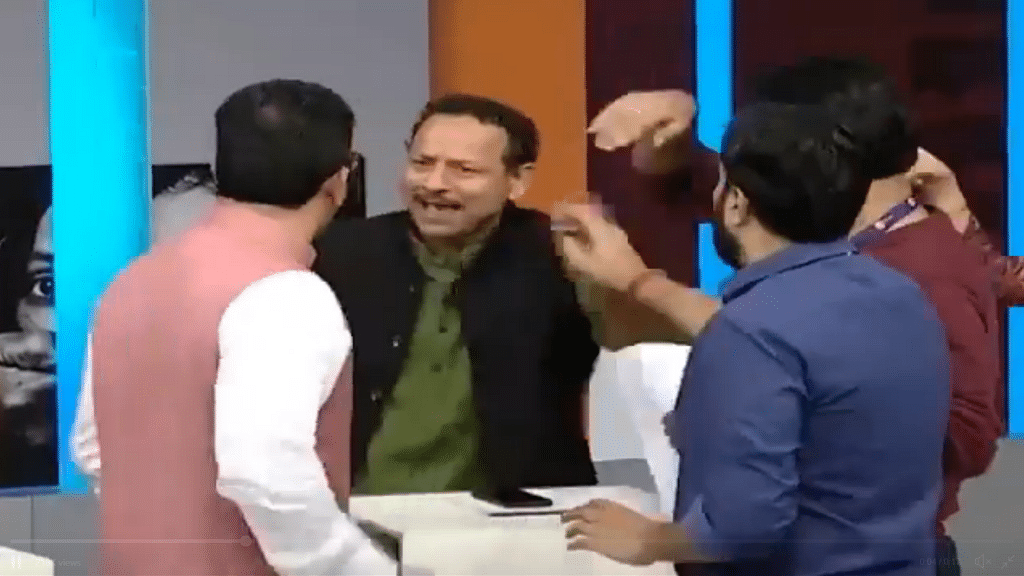After fisticuffs between BJP’s Gaurav Bhatia and SP’s Anurag Bhadoria, journalists Rajdeep Sardesai and Ravish Kumar hit out at deteriorating TV debates.
New Delhi: The detention of Samajwadi Party spokesperson Anurag Bhadoria by the Noida police after he was involved in a physical brawl with BJP national spokesperson Gaurav Bhatia Saturday is another indication that TV news discussions are increasingly mean, nasty and brutish.
During the TV show Yeh Kya Kehta Hai India on Zee News, a heated verbal exchange between the two politicians saw Bhadoria push Bhatia and the latter go after him. Later, the BJP politician lodged a complaint with the Noida police and Bhadoria was detained at the Sector 20 police station.
On Twitter, Bhatia said Bhadoria had “physically man handled” (sic) him: “I could have done the same but as a law abiding citizen, I have given a complaint against him.” Bhatia claimed Bhadoria had also insulted his family.
This is not the first such arrest. On 17 July, while debating triple talaq on Zee Hindustan, Muslim cleric Mufti Ejaz Arshad Qasmi assaulted Farah Faiz, a lawyer and human rights activist. He was arrested following a complaint by the media organisation.
Previously, too, there has been violence on air: In 2015, during a discussion on Radhe Maa, astrologer Deepa Sharma got up and slapped self-styled guru Om Ji Maharaj, and they got into a scuffle.
Also read: Indian TV news is hooked to MGM— no, it’s not a movie channel, but #ModiGetsMichel
‘Pull out a revolver?’
“It is disgraceful,” said Rajdeep Sardesai, consulting editor at TV Today, about the Bhadoria-Bhatia confrontation.
“All that’s left now is for someone to pull a revolver out in the TV studio,” warned Ravish Kumar, NDTV India’s prime time anchor, who hosts the weekday 9 pm show and has been a vocal critic of certain TV news channels and anchors who have replaced journalism with “propaganda”.
“This is a political and business model. It suits certain channels to let fights develop. They don’t want to stop it. What we condemn they will call a ‘great show’,” he added.
Times Now’s managing editor, Navika Kumar, disagreed: “I don’t know the context, but we also hold debates with argument and counter argument, and it has never come to this. This is a one-off case.”
A ‘crazy circus’
Sardesai said the violence and the police intervention is the culmination of turning the debate format into a ‘crazy circus’.
“The studio is a circus set and everyone is playing a part, but in play acting, something can go horribly wrong, or out of control — is the day far off when we see something like a stabbing on air?”
He recalled seeing audiences at travelling TV election shows throwing chairs at each other.
As politics becomes increasingly uncivil, especially during election season when the Prime Minister and the Congress president exchange barbs and accuse each other of lies and corruption, the TV news studio has seen temperatures rising to new levels between political opponents.
On Aaj Tak, on an election show on 20 November, BJP spokesperson Sambit Patra called Jawaharlal Nehru and the entire Gandhi family “Thugs of Hindostan”, after the Aamir Khan-Amitabh Bachchan film.
“These political spokespersons have nothing left to say. They don’t come to debate issues but talk about Modi or Rahul baba,” said Ravish, who believes that the political discourse at the highest levels has set the tone for the debates in studios.
While Sardesai agreed that the political discourse is at an all-time “low”, he felt journalists needed to be more “sensitive and responsible”.
“The nature of the debate is adversarial. Some anchors on some channels goad guests and invite the kind of abuse we hear,” he said.
Ravish believes that there is little journalism on many news channels, which instead encourage these ‘senseless debates’, which he believes are weapons to kill informed opinion in democracy.
Also read: Between Sardar Patel and Urjit Patel, TV news channels forgot Sri Lanka
Manufactured melodrama?
Impoliteness, abusive language and aggression have become the hallmark of many TV debates at prime time as news channels compete to attract viewers. It is routine for TV news anchors to yell at panellists and for guests to yell back and at each other.
The surgical strikes in 2016 and the subsequent demand that Pakistani actors not be allowed to work in India raised the pitch in TV studios. Debates grew acrimonious as TV anchors on channels like Times Now, Republic and Zee News labelled politicians, artistes and civil society members as “anti-nationals” if they did not agree to call out Pakistani actors.
In one instance, anchor Arnab Goswami, then on Times Now, asked actor Mita Vashisht to be removed from the studio (30 September 2016).
As anchors pit participants against one another to raise TRPs and promote a certain political agenda, panellists yell as much as anchors.
Senior journalist Saba Naqvi, a regular panellist on debates on Times Now and Republic, says she is “shocked by the rhetoric now used by politicians and participants. I try to stay out of it and not rise to the bait but it’s gotten personal”.
Manufactured melodrama is the name of the game — it’s clear when you watch a show such as Bhai vs Bhai on Zee News, featuring brothers Shehzad and Tehseen Poonawalla face off in an adversarial positions.
“There is no journalism in TV news, so this is what you will get,” Ravish concluded.
